
Background
Violet Town is a town of 936 people (as of 2021) in southeast Australia, located in the federal state of Victoria 149km/93mi north-northeast of Melbourne and 130km/81mi east of Bendigo (both measurements in linear distance).
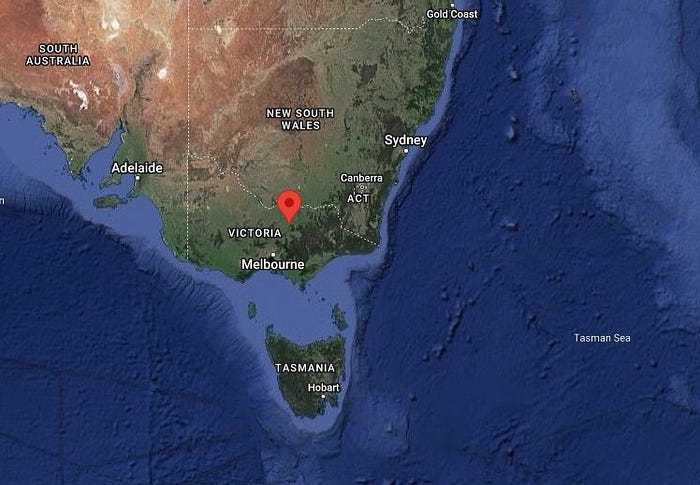
The town lies on the North East Railway Line, a partially electrified dual-gauge main line connecting Melbourne with the city of Albury. Dual-gauge refers to the line’s dual- to eight-tracked layout being constructed of regular gauge (1435mm width) railway tracks running alongside broad gauge (1600mm width) tracks. This is done to allow trains constructed for either gauge to run important connections rather than requiring goods and passengers to switch between regular- and broad gauge trains. At the time of the accident the section of the line surrounding Violet Town offered a single regular gauge track, with sidings (referred to as passing loops) at different towns to let oncoming trains pass each other. The Violet Town passing loop measured 915m/3002ft in length and was operated remotely from Centralized Traffic Control (CTC) at Melbourne.
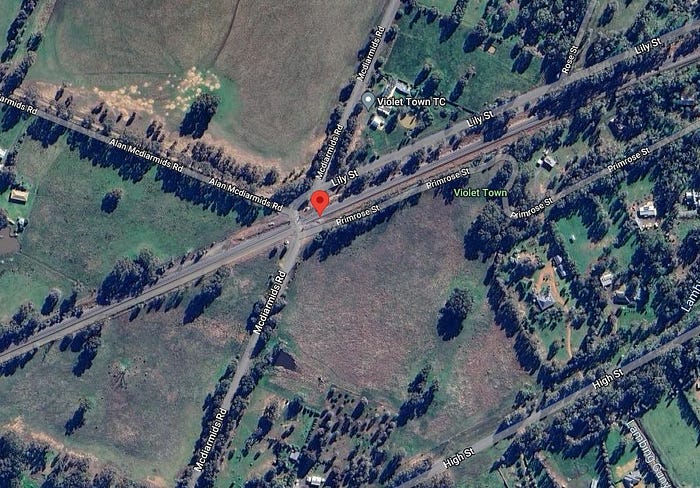
The Trains Involved
Goods train 428 was an early morning fast freight service from Melbourne to Albury, consisting of 22 freight cars, most of which carrying new cars, pulled by Victorian Railways (VR) S Class number 314 (shortened S314). The S Class is a six-axle multipurpose diesel locomotive introduced in 1957, being based off the North American EMD F7, a four-axle diesel locomotive. The S Class was built in versions for both broad gauge and regular gauge, with S314 being constructed in regular gauge. Each S Class measures 18.72m/61.5ft in length at a weight of 116 metric tons and could reach up to 133kph/83mph thanks to a supercharged V16 diesel engine producing 1350kW/1810hp. The type was mostly used for fast passenger express services, but also saw use in freight services. Each locomotive received a name along with their number, with S314 being christened Sir John O’Shanassy after a 19th century politician when it entered service in 1961. At the time of the accident the locomotive was under command of Mister Rosevear (30), assisted by his “fireman” Mister Brendecke (26). The term “fireman” had carried over from the era of the steam locomotives, when the fireman was mainly there to shovel coal into the firebox. Also riding on the freight train was a so-called Goods Guard, Mister Harris (37).
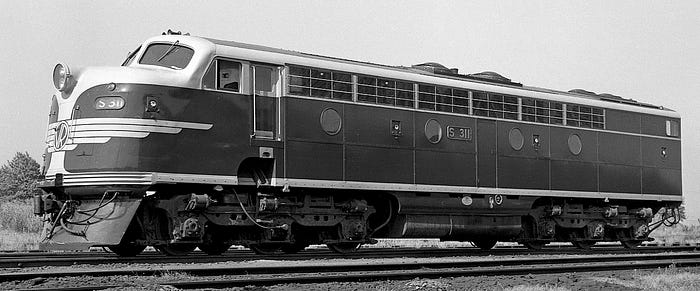
Heading the other way from Sydney to Melbourne was the “Southern Aurora”, a prestigious express passenger service established in 1962 when a regular gauge connection between the two cities was established. It, too, was pulled by a VR S Class, unit S316 Sir Andrew Clarke, and consisted of twelve four-axle express passenger cars in addition to a generator car behind the locomotive and a brake car at the back of the train. The train cars were (at the time) brand new New South Wales Stainless Steel train cars, constructed specifically for long distance services like the Southern Aurora and introduced in 1962. Their unpainted stainless steel exteriors made them distinct from the standard steel passenger cars. As an overnight service the Southern Aurora consisted largely of sleeper cars along with lounge and dining cars. Contemporary sources put the weight of the express train at 750 metric tons including the locomotive.
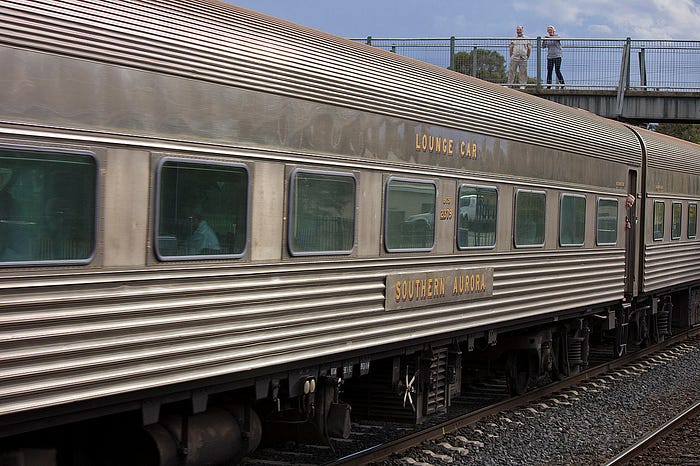
At the time of the accident the Southern Aurora involved in the accident was nearly at capacity, carrying 192 passengers and 22 crew members. It was driven by Mister Bowden (52), assisted by Mister Coulthard (30), his fireman. Mister Bowden had 31 years of experience as a driver and was known as one of the best in the business, having excellent route knowledge and putting high value on punctuality, often reminiscing about “good old times” when people could set their clocks by the arrival and departure of the long distance express trains. He had developed his punctuality into a noted skill, being unusually good at regaining lost minutes without breaking the rules.
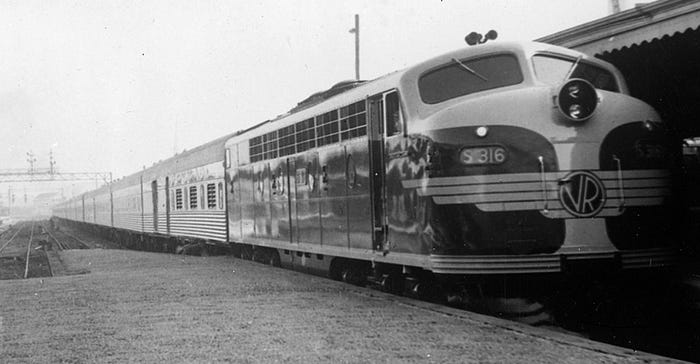
The accident
On the 7th of February 1969 Mister McDonnell is working the morning shift as a train controller for VR at the CTC in Melbourne. He is seated at a large control panel with several lights indicating the positions of the trains along the Melbourne-Albury rail line. At approximately 6:30am his attention is focussed on two trains in particular. The 1:25am freight service from Melbourne to Sydney and the southbound Southern Aurora. Upon checking the timetable he notices that the latter, ironically driven by a driver known for punctuality, is running late. Mister McDonnell knows that one train will have to let the other pass at or around Violet Town, but which way is he going to set up the passing maneuver? Usually freight trains give way to passenger services, but that would load the freight service with a 100 minute delay due to the Southern Aurora’s current small delay. As such Mister McDonnell decides to not stop the freight service as scheduled but instead let it proceed to the Violet Town passing loop. To facilitate this the Southern Aurora has to slow down too, but careful calculation tells Mister McDonnell that both trains might get away with a so-called “running cross”, passing each other at a siding at barely more than walking pace rather than requiring either train to come to a full stop and then get going again. Satisfied with his solution Mister McDonnell radios the driver of the freight train, Mister Rosevear, and sets the signals for the Southern Aurora.
The Southern Aurora has just departed Glenrowan station, 50km/31mi linear distance from Violet Town, with Mister Bowden checking his watch to time his delay. The rail line heads steeply downhill south of Glenrowan, and Mister Bowden knows that by running his train right at the 97kph/60mph speed limit he can shorten his delay by a full minute. The line eventually levels out near the town of Benalla, with a raised speed limit allowing Mister Bowden to accelerate to 113kph/70mph. Mister Bowden thus gives a full throttle input as he settles back in his seat. Except for a slight S-bend taking the narrow gauge track around the broad gauge station at Violet Town the next several kilometers are straight and level, easy travelling for the express train.
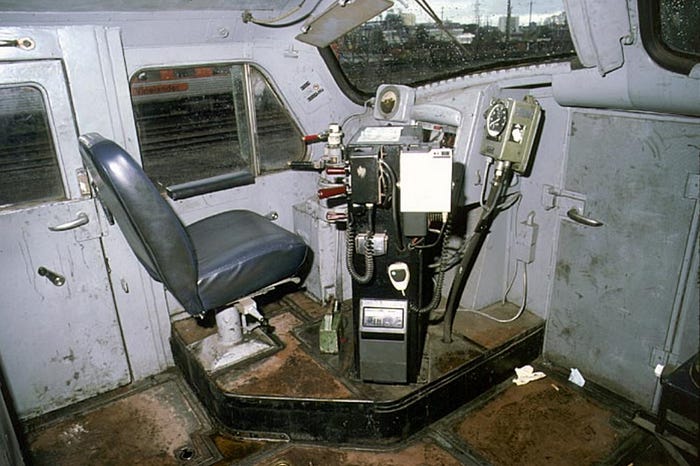
Mister Coulthard, the fireman on the Aurora, glances out the windshield at 7:00am, and spots a yellow warning signal in the distance. The signal warns drivers that the next signal would likely order a stop, and it was standard practice to reduce train speed by 16kph/10mph upon passing the warning signal. Upon spotting the signal Mister Coulthard notes “”It looks like we may be having a bit of a stop. I’ll put the kettle on.” and gets up, climbing into the nose cone of the locomotive where he can draft water from an onboard tank. He doesn’t feel the train slow down while he fills the kettle, instead he feels the locomotive rumble over the points at the beginning to the passing loop. Returning from the nose cone he notices that his colleague is still sitting in his chair, leaned back with the throttle all the way open. He looks over to the passing loop, finding it oddly empty. If they were to proceed through the loop, there should be a train parked there to let them pass. Turning back to face straight ahead he’s shocked by seeing the red “stop”-signal close in on his train at full speed, and worse yet, he can see a freight train beyond the signal, headed right for them. Knowing that they’re out of time to stop Mister Coulthard shouts at Mister Bowden that there’s a red light ahead and flees to the engine compartment in the center of the locomotive.
Meanwhile, on the freight train, Mister Rosevear is approaching Violet Town at 80kph/50mph as he remarks that he can see the express train “wait for them” in the distance, making out S214’s headlights. He applies his brakes in preparation of being diverted into the siding, reducing his speed to 60kph/35mph. Still observing the express train in the distance, which doesn’t seem to slow down. “It’s going fairly hard” he notes to his fireman, Mister Brendecke, as worry begins to creep in. His amusement at a freight train being given priority over the prestigious express is gone. Now both men are fixated on the express train, moments before it swings around the bend at Violet Town Station. “It’s still coming!” he yells out as he hurriedly applies full brakes with one hand while starting to flash his headlights with the other. Seeing the futility of his actions Mister Rosevear gets up and opens the driver’s side door to the cab. Mister Brendecke takes the hint, opens his side’s door, and climbs down the outside ladder. He hesitates on the bottom step, seeing the ballast and sleepers race past beneath him. Looking up, he can see Mister Rosevear head for the engine compartment. A last glance back to the freight cars, a last glimpse at the oncoming express train. The Southern Aurora is less than 25m/80ft away when Mister Brendecke jumps off his train. The two trains collide head on the second Mister Brendecke’s feet are off the ladder, at a combined speed of 164kph/102mph.
A deafening crash rings out as the two locomotives make contact, with impact forces so violent that the Southern Aurora’s locomotive is thrown several meters up into the air before crashing back down. A witness on the adjacent highway later reports feeling the ground move beneath his car as a freight car went even higher than the opposing locomotive, throwing its cargo in all directions. The leading two cars of the southern Aurora sleeve over the back of their locomotive and each other as the locomotive comes back down, another two ride up onto the wreckage, becoming lodged some 9m/30ft off the ground. Spilled diesel fuel from S314 ignites as the trains come to a rest, with the blaze soon spreading to the forward cars of the Southern Aurora. Mister Rosevear, along with two crewmembers of the Southern Aurora, perishes in the crash, as do 5 of the Southern Aurora’s passengers, with another 117 people being injured.

Aftermath
Local volunteer firefighters happened to witness the accident as it unfolded and went to raise the alarm while passing motorists were the first outsiders to render aid to survivors. Due to some miscommunication the alarm that went out to the surrounding fire stations initially reported a collision between two trucks, being corrected to a train hitting a truck at the level crossing. Firefighters were not aware what had actually occurred until they reached the sprawling wreckage, where it became clear that things were far worse than anticipated. Over 100 firefighters would soon be involved in the rescue effort, arriving by car or plane from surrounding districts.
While he was originally assumed deceased Mister Brendecke had actually survived his jump from the speeding train. He had “kept rolling” after hitting the ground, clearing the rail line by enough distance to see the freight train’s locomotive launch its counterpart into the air. A freight car came down right on top of him (sources differ on whether it missed him by inches or landed on top of him with just enough space left not to crush him), knocking him unconscious. After regaining consciousness he crawled out of the wreckage, grabbed a nearby metal bar and tried smashing windows to help rescue survivors, finding his right shoulder unusable. Many of the car’s doors were jammed, and the nearby fire was adding to the panic of the survivors. Firefighters managed to keep the fire at bay long enough for all survivors to be rescued, despite the flames eventually consuming four passenger cars, several freight cars and the generator car no victims died from fire or smoke.

It took a few hours for responders to be able to approach S316, which had been largely gutted by the fire. They recovered Mister Bowden’s remains from the wreckage, the 9th and final dead body to be pulled from the wreckage. His body was sent off to have an autopsy performed on it, intending to figure out if he had maybe disregarded signals due to being intoxicated. It would be out of character for him, but such a check is a standard procedure in rail accident investigations. Instead, they found something that stumbled them even more than any amount of alcohol or drugs could. Mister Bowden had not been alive when his train crashed into the oncoming freight train. Further examination and calculation showed that he had passed away from a heart attack prior to the collision, dying approximately 10km/6mi ahead of the site of the collision, and probably not being in full control of the train for some time before that. When he hadn’t responded to his fireman ahead of the accident it hadn’t been ignorance or the fireman being drowned out by the noise of the locomotive, he had simply been already dead, remaining leaned back in his chair as he had been sitting.
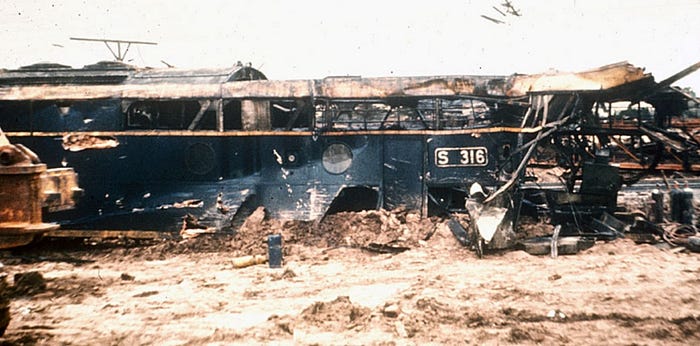
Workers spent the night following the accident chipping away at the center of the wreckage, finally unearthing the remains of the leading passenger car at the center of the rubble. The car, which could hold a few dozen people, was found to be empty. Everyone in it had gone to the restaurant car for breakfast just before the accident. In the meantime investigators seized Mister Bowden’s medical records, and found that the fatal heart attack hadn’t come without warning. His mother had passed from a heart attack in her early 50s, and Mister Bowden himself had required medical attention after an undefined “heart-related event” during a fishing trip about a year before the accident. When his doctor advised him to inform his employer Mister Bowden explained that he couldn’t, not only would the possible end to his train driving career mean a financial loss but it was also his life’s passion. He assured the doctor that he always rode with a fireman as per the railway company’s guidelines, and that the fireman was fully qualified to take control of the train if the driver becomes incapacitated. And thus, the medical issues Mister Bowden was burdened with went unknown to the railway company. The Coroner found some clear words for that decision, writing in his report to the Investigation:
“He [Mister Bowden] was extremely negligent in persisting in driving what might well be called a prestige train, knowing that he was a candidate for death at any moment; and, in effect, admitting that if death did overtake him on the train, the safety of the passengers, crew and equipment would depend upon the fireman pulling up [stopping] the train.”
Continuing on the Coroner zeroed in on Mister Coulthard, the surviving fireman from the Southern Aurora, next, referencing calculations that the train had gone past the speed limit in the moments before the crash:
“When the steady and reliable driver was apparently acting in an unusual fashion by travelling at a speed which was prohibited under any circumstances (more than 113 km/h (70 mph)), but in this case was aggravated by passing a caution automatic signal, and had made no attempt to implement what the signal connoted, he [Mister Coulthard] left the cabin to fill the kettle. He did this at a time when other drivers (including Bowden on a prior trip) had slackened speed by at least 15 km/h (10 mph), and at a time when Coulthard knew there were other signals coming up and that it was his duty to observe.”
The official report adds to this that the conductor’s logbook was found to be “largely a work of fiction”, and that he had gone to sleep in his on-train office shortly after the train left Albury. When questioned on discrepancies between his records and the train’s actual movements he admitted as much, also admitting that he watched the train pass the yellow and red signals without slowing down before he reached for the emergency brake handle, at which point the collision threw him to the ground.
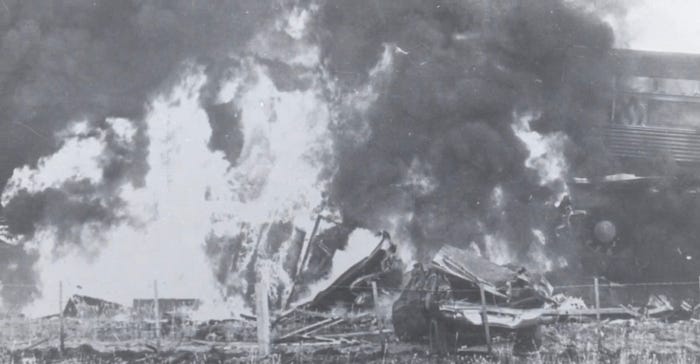
After much consideration the investigation chose not to recommend manslaughter charges against Mister Coulthard (the fireman) and Mister Wyer (the conductor), justifying the decision by explaining that their negligence was obvious, but not extreme enough to justify being put on trial. Furthermore, their negligence would have been without consequence had Mister Bowden not acted in staggering negligence regarding his health. The information about the two men’s behavior was forwarded to their employer, and within a week Mister Coulthard was fired while Mister Wyer was demoted to working at a station rather than on trains. With that, nobody was ever put on trial for the events that shook the small town and claimed the lives of eight (Mister Bowden is usually excluded from the list of fatalities) people. The wreckage was cleared within a few days, and the rail line was soon rebuilt. Four of the Southern Aurora’s train cars and some of the freight cars were returned to service, the rest was hauled away for scrap. For 25 years, nothing at the site pointed to the tragedy that had occured, before a small memorial consisting of a plaque on a stack of rocks was set up at Violet Town station.
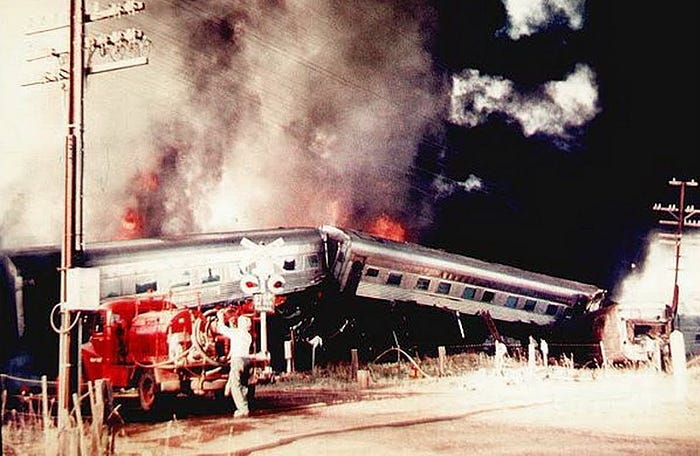
Nowadays the concept of two-men locomotive crews is on its way out, with technology largely negating the need for a second set of eyes. At the time of the accident the motion of the train was entirely down to the locomotive crew obeying signals, speed limits and orders from the traffic control center. If a train driver chose to speed or ignore a signal there wasn’t much from stopping him unless the assistant/fireman intervened, and about the same goes for an incapacitated driver. On the day of the accident Mister Coulthard talked to Mister Bowden, who was already incapacitated (if not deceased) at that point, and didn’t grow suspicious by the lack of a reply. This allowed the effectively out of control train to speed past both a warning and a stop-signal uninhibited.
Most trains nowadays are equipped with a dead man’s switch, in the form of a pedal or button that must be pressed either constantly or at regular intervals depending on the system in use. The idea is that a distracted or incapacitated driver would fail to do so, triggering (usually a warning and then) an automatic stop. In addition to that system more and more rail lines around the world are equipped with automatic train control systems (ATC), which are trackside systems which can force a train to stop if it breaches the speed limit or ignores a red signal, regardless of driver input. This, in contrast to the dead man’s switch, can stop trains purposely driven in disregard of orders, instead of only activating if the driver is no longer attentive. Had the Southern Aurora been fitted with those two systems, it’s very likely that, even with the negligent approach by Mister Bowden to his health, the accident wouldn’t have occurred as his train would’ve been forced to a stop instead of racing right past the passing loop.
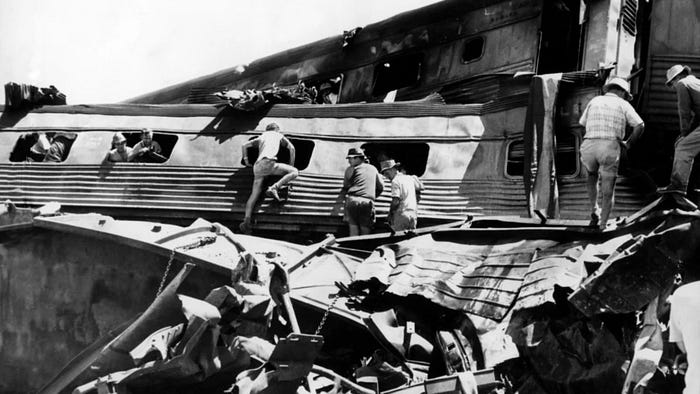
The Southern Aurora suffered declining attendance for a few years before performing its final service in August 1986. Many of the stainless steel passenger cars were sent to various museums, some of which maintained them in operational condition. In recent years enthusiasts have repeatedly organized revival-trips, running preserved Southern Aurora train sets on the connection it used to serve. The S-Class locomotives largely retired around the turn of the millenium, with just 3 units remaining in service and another 7 being preserved in various conditions.
In 2018 a local group at Violet Town announced plans to significantly expand the memorial, calling the existing version wildly inadequate. The new memorial, consisting of a large garden, several murals, picnic benches, a preserved (but gutted) stainless steel passenger car, photos of the wreckage and signage listing both the victims, survivors and local rescuers was unveiled in 2020, 51 years after the accident occured. The new memorial encompasses a significant area stretching from Violet Town station along the rail line to the site of the crash.

Video
The County Fire Authority published a video showing the rescue and recovery-effort in 2019. Be aware that the images might be distressing to some viewers.
_______________________________________________________________
A kind reader is posting the installments on reddit for me, I cannot interact with you there but I will read the feedback and corrections. You can find the post right here.
